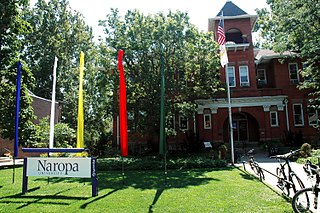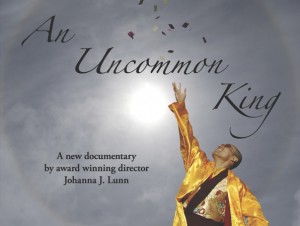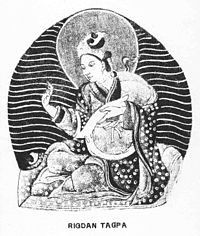
Chögyam Trungpa was formally named the 11th Zurmang Trungpa, Chokyi Gyatso. A Tibetan Buddhist master and holder of both Kagyu and Nyingma lineages of Tibetan Buddhism, he was recognized by both Tibetan Buddhists and other spiritual practitioners and scholars as a preeminent teacher of Tibetan Buddhism. He was a major figure in the dissemination of Buddhism in the West, founding Vajradhatu and Naropa University and establishing the Shambhala Training method. The 11th of the Trungpa tülkus, he was a tertön, supreme abbot of the Surmang monasteries, scholar, teacher, poet, artist, and originator of Shambhala Buddhist tradition.

Pema Chödrön is an American-born Tibetan Buddhist. She is an ordained nun, former acharya of Shambhala Buddhism and disciple of Chögyam Trungpa Rinpoche. Chödrön has written several dozen books and audiobooks, and was principal teacher at Gampo Abbey in Nova Scotia until recently. She retired in 2020.
Reginald Ray is an American Buddhist academic and teacher.

Naropa University is a private university in Boulder, Colorado, United States. Founded in 1974 by Tibetan Buddhist teacher Chögyam Trungpa, it is named after the 11th-century Indian Buddhist sage Naropa, an abbot of Nalanda. The university describes itself as Buddhist-inspired, ecumenical, and nonsectarian rather than Buddhist. Naropa promotes non-traditional activities like meditation to supplement traditional learning approaches.

Dilgo Khyentse Rinpoche, Tashi Paljor was a Vajrayana master, Terton, scholar, poet, teacher, and recognized by Buddhists as one of the greatest realized masters. Head of the Nyingma school of Tibetan Buddhism from 1988 to 1991, he is also considered an eminent proponent of the Rime tradition.

Gampo Abbey is a Western Buddhist monastery in the Shambhala tradition in Nova Scotia, Canada on the edge of the Pleasant Bay community. Founded by Chögyam Trungpa Rinpoche in 1983, it is a lineage institution of Shambhala and a corporate division of the Vajradhatu Buddhist Church of Canada.
Surmang refers to a vast alpine nomadic and farming region, historically a duchy under the King of Nangchen, with vast land holdings spreading over what is today the Tibet Autonomous Region and Qinghai Province. In Tibetan the King of Nangchen's realm was called the "nyishu dza nga" or the 21 (provinces). Since 1959 it is mainly within the Yushu Tibetan Autonomous Prefecture of Qinghai province in China. Yushu Prefecture is 97% ethnic Tibetan. The Surmang region is one of the poorest regions in China ranking it among the world's highest infant and maternal mortality, almost 100% illiteracy, and personal income of less than US 14¢/day. It is part of the catchment in China of the 30 million ultra-poor.
Choseng Trungpa Rinpoche is the 12th and current Trungpa tülku. He was born on February 6, 1989, in Pawo village, in Derge, eastern Tibet. He was recognized by Tai Situ Rinpoche in 1991, and enthroned a year later at Surmang Monastery at a ceremony presided over by Domkhar Rinpoche, a high Kagyu lama and Choseng's uncle. The monastery's late abbot, was Chogyam Trungpa Rinpoche.

Vajradhatu was the name of the umbrella organization of Chögyam Trungpa Rinpoche, one of the first Tibetan Buddhist lamas to visit and teach in the West. It served as the vehicle for the promulgation of his teachings, and was also the name by which his community was known from 1973 until 1990. Starting in 1976 it was paralleled by a governmental structure for establishing the non-denominational enlightened society of Shambhala Kingdom, which included Shambhala Training among many other activities. In February 2000, the Vajradhatu organization was renamed Shambhala International by Sakyong Mipham Rinpoche.

Sakyong Jamgon Mipham Rinpoche, Jampal Trinley Dradül was born as Ösel Rangdröl Mukpo, and is a Tibetan Buddhist master and holder of the Sakyong Lineage of Mukpodong, his family lineage. The Sakyong was recognized by Penor Rinpoche in 1995 as the tulku (reincarnation) of Ju Mipham Gyatso the Great, the renown Rime teacher of the late 19th century who stated he would only be reborn in Shambhala.

Shambhala International is the umbrella organization that encompasses many of the distinct institutions of the Shambhala spiritual community, founded by the students of the Tibetan Buddhist teacher Chögyam Trungpa Rinpoche.

Ösel Tendzin, born Thomas Frederick Rich Jr., was an American Buddhist. He was the principal student of Chögyam Trungpa. On August 22, 1976, Trungpa empowered Tendzin as his Vajra Regent and first Western lineage holder in the Karma Kagyu and Nyingma schools of Tibetan Buddhism. On August 25, 1990, Tendzin died of HIV/AIDS in San Francisco, California, aged 47. His wife, Lila Rich, and a group of his students continue to live in Ojai, California.
Shambhala or Shambala is a mythical kingdom in Tibetan Buddhism.

The Great Stupa of Dharmakaya Which Liberates Upon Seeing is located at Drala Mountain Center in Colorado, USA. It was built to inter the ashes of Chogyam Trungpa, who died in 1987. In many Buddhist traditions it is common to build a stupa to honour a respected teacher after their death. The site of the Great Stupa of Dharmakaya was first identified as an auspicious location by the 16th Karmapa, head of the Kagyü school of Tibetan Buddhism, on his first visit to North America in 1974.

Lion's Roar is an independent, bimonthly magazine that offers a nonsectarian view of "Buddhism, Culture, Meditation, and Life". Presented are teachings from the Buddhist and other contemplative traditions, with an emphasis on applying the principles of mindfulness and awareness practices to everyday life.

Dechen Chöling is the residential practice center of the European Shambhala Buddhist community. The center sits in a land of rolling meadows near Limoges, France.
Basic goodness is a term coined by Tibetan spiritual teacher Chögyam Trungpa Rinpoche and is a core concept in his terma. It is used both to discuss the experience of reality and also basic human nature, which arises as fundamental virtue. Everything that arises is, at the ground level from beginningless time, good.

Shambhala Training is a secular approach to meditation and a new religious movement developed by Tibetan Buddhist teacher Chögyam Trungpa Rinpoche and his students. It is based on what Trungpa calls Shambhala Vision, which sees enlightened society as not purely mythical, but as realizable by people of all faiths through practices of mindfulness/awareness, non-aggression, and sacred outlook.

Shenlha Ökar or Shiwa Ökar is the most important deity in the Yungdrung Bon tradition of Tibet. He is counted among the "Four Transcendent Lords" along with Satrig Ersang, Sangpo Bumtri, and Tonpa Shenrab Miwoche.

An Uncommon King is a 2011 72-minute HD documentary film directed by award-winning documentary and television producer Johanna J. Lunn. It records the life of Sakyong Mipham Rinpoche, son of meditation master Chögyam Trungpa and leader of the Shambhala Buddhist lineage and Shambhala International, a global community with over 200 meditation centers.












